In the world of lighting design, few names resonate as powerfully as Sooner Rae Routhier. With an illustrious career adorned with accolades such as the Parnelli Award, Live Design Achievement Award, Live Production Summit Pinnacle Award, and multiple Top Dog honors, Sooner has established herself as a true luminary in the industry.
From captivating millions with her work on shows like Jimmy Fallon, The AMA’s, The Ellen Show, The Voice, and The Billboard Music Awards, to crafting unforgettable performance moments for renowned artists like Coldplay, Panic at the Disco, The Weeknd, and KISS, Sooner’s artistry knows no bounds. However, it is not just her exceptional talent that sets her apart. In 2020, when the live entertainment industry faced an unprecedented crisis due to the COVID-19 pandemic, Sooner took action. She co-founded EVEN—an organization dedicated to fostering diversity and inclusivity within the live events industry. Through outreach, training, mentorship, networking, and job placement, EVEN strives to pave the way for a more equitable future.
In an exclusive interview, we had the privilege of delving into her remarkable journey. Join us as we uncover the artistry, passion, and expertise of Sooner Routhier, both as a lighting design virtuoso and as an esteemed member of the LIT Lighting Design Awards jury.
Can you tell us a bit about how your passion for light design started?
To be honest, I fell in love with scenic design and construction before lighting! When I was in elementary school, l performed in a summer stock theater. The theater where we performed was a bike ride away from my house and I would ride over to help the scenic designer build the sets for the musical. I LOVED the maker aspect of scenic design.
When I entered high school, I took up dance. However, I was a terrible dancer! My instructor, my original mentor Cheri Skurdall, gently pushed me into tech theatre. It was then that I fell in love with lighting for music, theater, and dance. I realized that I loved the feeling of operating lighting to music. The way it reacted with sound.
I saw my first large concert when I was a senior in high school – Smashing Pumpkins Melancholy and the Infinite Sadness Tour. It was then that I knew EXACTLY what I wanted to do. The colors, beats, effects, all of it…. The way the lighting affected our emotions while listening to the Pumpkins on stage was magical.
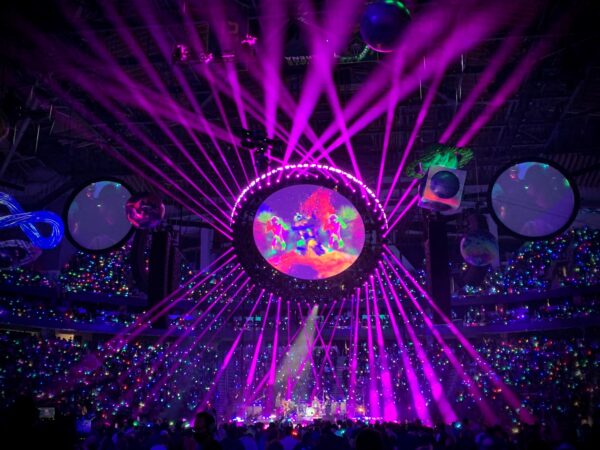
Coldplay – George Masek
Why and how did you start work in the Entertainment Lighting industry?
My parents recognized early on that I needed to attend university closer to home. I had dreams of attending Full Sail University to study concert lighting. However, they knew that I tended to get home sick easily – VERY ironic as I’m constantly traveling. They nudged me to a smaller school in Vermont called Johnson State College. It was there that Jan Herder, the tech director of the theater, had me operating the lighting console just about every day. In the fall of my freshmen year, a band came to play in the theater and rented additional lighting and audio support from a vendor hire in New Hampshire (New England Audio Tech). The lighting person that traveled with the system was named Brian Clark. He labeled his lighting console with gel color numbers instead of the typical “red,” “blue,” “green.” I was a big nerd about lighting and had studied all the gel swatch books. When I operated the console for him and he asked me to pull up the red fader, I would illuminate the fader labeled “R27.” He was shocked at my knowledge. I asked to tag along on the next few shows. I was hired 6 months later!
How do you approach a new project? Do you have a special philosophy or steady inspiration?
The process is different for every project. However, they almost always start out with research. I work hard to figure out the past, present, and future of an artist. Inspiration comes directly from the artist. I love to tailor a production to the current direction that the artist is moving in.
If all your projects wouldn’t speak for themselves, all the awards you’ve won surely would. How does it feel to be recognized in the industry?
Very weird to be honest. I think it’s ingrained in me to be behind the scenes so being recognized can be a bit uncomfortable. It’s also incredible! I used to read Lighting Dimensions magazine when I was a kid. The first time I was interviewed for it was a dream come true!
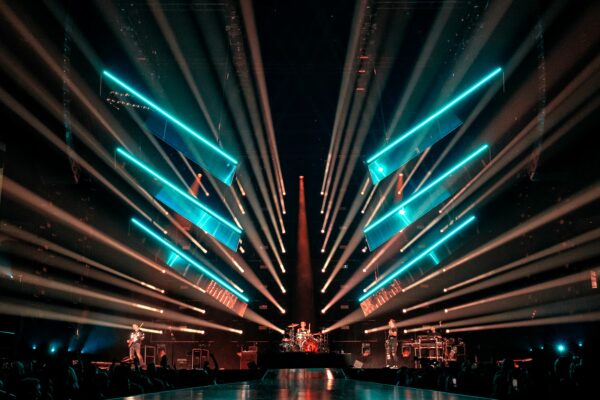
Muse – Todd Moffses
Working in different kinds of mediums such as live stages and television studios must come with its challenges, how do you adapt your techniques and designs to these different platforms?
We try to understand what the scope of the tour will be before we put pen to paper. If the tour includes festivals, promo, etc… we try to design elements that will fit in all the mediums. Doing this allows the artist to maintain a bit of the visual identity across all shows. For example, if an artist is beginning an album cycle they might start with television promo. If this is the case, we try to design elements that can be used in the TV setting and then transition onto a large concert stage by being altered slightly.
Although this might be a difficult question to answer, what is the project you’ve enjoyed working on the most so far? Which was The One?
I don’t have a project that is “The One.” I do have an experience however! When Coldplay released their album “Everyday Life,” they did so amongst some Roman ruins in Amman Jordan. We built a concert stage amongst the ruins in the center of the city. They performed a sunrise and sunset performance followed by a full-length concert. It was the most incredible experience to be surrounded by the ruins and the local culture. We would stop at call to prayer and watch as beautiful white birds were swooping throughout the valley in the city. It was the most stunning combination of music, nature, culture, and history.
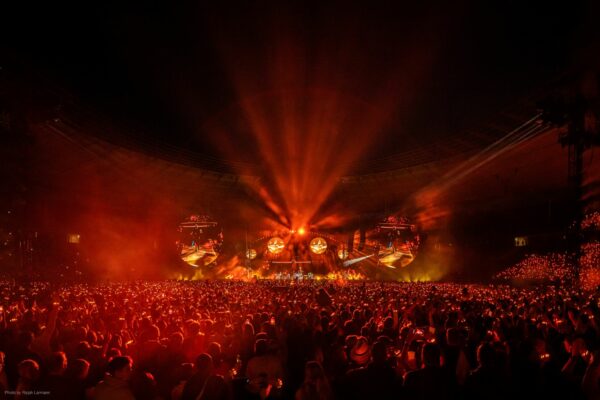
Coldplay – Ralph Larmann
After the pandemic, you partnered up with fellow designers and created EVEN. Can you tell us more about the organization and its mission?
The founders of EVEN recognized that our industry was about to lose about 20% of its work force during the pandemic. EVEN was created to try to build the work force back in a more diverse manner. We are a team of industry professionals that recognized that there is a visibility problem with our backstage industry. We are behind the scenes by design. We make the magic happen so that the artist can shine brightly on stage! We developed a program with four distinct pillars: Community Engagement, Education, Mentorship, Paid Apprenticeship Placement. The program is a pipeline from awareness to first gig.
What are some of the major inspirations you apply to your work?
I’m inspired by just about everything! Nature, store displays, galleries, architecture, fashion. It really runs the gambit. I work with a very diverse group of artists from all different genres of music and entertainment. Inspiration for projects is just as diverse!
Which advice would you give to an aspiring lighting designer that would love to follow in on your steps?
There are so many things!!
One of the biggest things that I learned early on – thankfully – was how important it is to get finances in line. This is boring business stuff! Sorry! As freelancers, we aren’t covered by 401Ks and disability insurance. It’s important to get a plan together so that you’re covered if things get challenging. I find that a lot of younger designers struggle with this in the beginning of their careers and it really messes with them later down the line.
In line with the boring business stuff is contracting and insurance. It’s so so so so important to cover yourself with these things!
Also, the ever old cliché – “never stop learning.” I find that I learn from people of all ages, those younger AND older than me! Don’t turn someone away because they are younger or have less experience then you. Always take the meeting because you never know what you could learn!
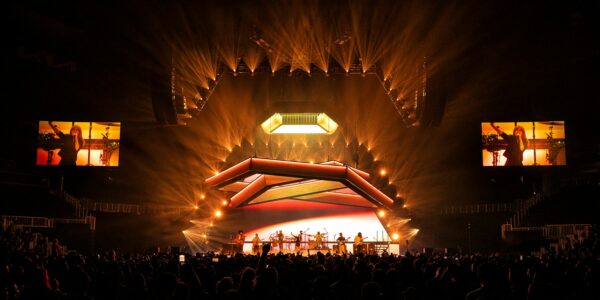
Paramore – Todd Moffses
Do you think you should sit amongst the best Lighting Designers and Lighting Product designers of your generation?
The LIT Design Awards™ was established with the aim of acknowledging the exceptional work of talented lighting product designers and implementers from around the world. We firmly believe that lighting encompasses both artistic expression and scientific principles, making it a vital component of any design.
The LIT Awards was envisioned as a platform to recognize and honor outstanding achievements within the realms of lighting products, Architectural and Entertainment lighting designs.
LIT Lighting Design Awards is a partner of the LEDforum.23 held in São Paulo, Brazil, on the 16th and 18th of August.
LEDforum is known nationally and internationally for offering lectures and activities of high technology and knowledge level, conducted by great names in the Brazilian and international lighting universe. It presents an opportunity for launching lighting systems and Lighting products, generating new business and unbeatable networking opportunities.
The event brings together an audience of lighting designers, architects, product designers, urban planners, landscape designers, academics, developers, and providers of lighting solutions, coming from different regions of Brazil and Latin America.
The LIT Lighting Design Awards will be holding an Award Ceremony, introducing its regional winning projects and inviting winners on stage.
More information on the LEDForum website.
On Wednesday, 19th of April 2023, the annual Asia Pacific Design Center (APDC) Gala was held at the elegant Sofitel Foshan in China. Celebrating Design excellence, the Chinese winners of the 3C Awards programs – BLT Built Design Awards, LIV Hospitality Design Awards, SIT Furniture Design Awards and LIT Lighting Design Awards – have been awarded.
Among all winners, Fang Fang has honored for winning the LIT Lighting Design Awards “ Lighting Design of the Year 2019” for the Museum of International Design of China.
Zhike Wang and Xiaoshui Li from FOSHAN TOPWAY DESIGN, winner of the BLT Built Design Awards 2021 “Interior Design of the Year,” were called onto the stage.
Karl Yin received his “Product Design of the Year 2022” certificate for the BLT Built Design Awards with YiBrick.
Winner of the BLT Built Design Awards 2022 in “Architectural Design,” Eason Zhu, designer at Fununit Design, joined the celebration and received his certificate for “The Lost Garden.”
Discover the award-winning designs and designers of the APDC Gala by viewing all the photos at this link. Thanks to our partner APDC for organizing this spectacular event and honoring such talented architects and interior designers.
Take a moment to look at the Best of 2022 Lighting Product and Lighting Designers.
Meet Hervés Descottes, Principal of L’Observatoire International and winner of “Lighting Design of the Year” with “The Hermès’ collections at Milan Design Week 2022” and Mykola Kabluka, founder of Expolight winner of the “Lighting Product Design of the Year” award for the “Chandelier in the B14 UNIT. City business space” and hear from the Emerging Designers, Owen Fernando Patia and Elsa Gil Benito.
Don’t miss the chance to meet Patrick Woodroffe and Dave Kavanagh receiving the “Lifetime Achievement Awards” for their incredible design contributions and from Mark Stanley of The Studio School of Design being awarded the “Spotlight” Prize for the school engagement towards education accessibility, diversity, and inclusivity.
“I am absolutely delighted to be honoured with this inaugural lifetime achievement award at such a young age! I have every intention of continuing my career in the same way as I have been, ensuring I remain worthy of this great honour.” – Kevan Shaw, LIT Lifetime Achievement Recipient
Kevan Shaw’s career in lighting began over 40 years ago, 30 of which have been at his firm, Kevan Shaw Lighting Design.
Kevan’s achievements in the field of lighting design consist of more than 700 projects completed worldwide and across a broad range of fields. Notable projects include the Scottish Parliament Debating Chamber, the Ashmolean Museum in Oxford and the Scott Monument in Edinburgh.
We are delighted to give this award to Kevan and we continue to expect great things from his career in lighting design! Please read his expanded biography/background in lighting and see more of his work here.
For over 30 years, Sally Storey has been guiding John Cullen Lighting and founded Lighting Design International company, gathered a talented team of designers from a variety of backgrounds: architecture, theatre design, fine art, product design and engineering.
Sally has been pushing the boundaries of technology and design to create outstanding spaces and memorable experiences. She has written three well-received books on lighting and often contributes to the national and international press. Sally Storey’s contribution to the Lighting Industry is tremendous!
Sally Storey studied architecture at Bristol University and in her second year was awarded the scholarship of the year. She was fascinated with how natural light and artificial light transformed a building and chose this as her thesis and never looked back.
Sally Storey, Design Director of Lighting Design International and John Cullen Lighting, is one of the UK’s leading lighting experts. Her extensive knowledge and experience has led to her travelling all over the world designing lighting schemes for esteemed brands, individuals and corporate clients.
Sally has written three well-received successful books on residential lighting and often contributes to the national and international press. She is a regular speaker at interior design and architectural events and conferences. Sally is a judge on many interior and lighting panels, and currently a judge for the Super Yacht Design & Innovation Awards.
Recent projects include the Kimpton Fitzroy London, Hotel Café Royal, L’Oscar, the multi-award-winning Fera at Claridge’s Hotel, The Lanesborough Hotel Spa, The Connaught Hotel, Ham Yard Hotel, The Savoy, Temple Church, Grocer’s Hall, Grand Hotel Cap-Ferrat, Emirates Palace Hotel Dubai, Crosby Street Hotel New York, St Regis Venice and Four Seasons Hotels including the spa at the Four Seasons George V.
Sally has also been involved in Private Residences and Palaces worldwide as well as numerous Super Yachts including the award-winning Topaz (J8), Northern Star, MY& SY Twizzle, JOY, Faith, Hasna, Lady S and most recently Archelon.
Project: Kimpton Fitzroy, London
Company: Lighting Design International
Photographer: Gavriil Papadiotis
Project: ESPA Life at Corinthia
Company: Lighting Design International
Photographer: Richard Powers
Project: Duplex Penthouse, London
Company: Lighting Design International
Photographer: Andrew Beasley
Project: Duplex Penthouse, London
Company: Lighting Design International
Photographer: Andrew Beasley
Sally has brought her residential lighting experience to create outstanding lighting schemes that make the stunning spectacular. Sally has been a key advocate in promoting residential lighting a vital element of interior design.
No matter the budget lighting can transform and make simple materials look elegant. Sally’s passion and enthusiasm for lighting never fade and still comes through when lecturing today. She is currently working on her fourth book on residential lighting which aims to help one understand new technology and how best to use it. This is aimed at interior designers, architects and the homeowner. Making people aware of their environment will hopefully influence push the standards of lighting in work and leisure.
Project: Heckfield Place, Hampshire
Company: Lighting Design International
Photographer: Sprately & Partners
Sally Storey’s Publications:
Lighting: Recipes and Ideas London: Quadrille, 2000
Lighting by Design London: Pavilion, 2002
Perfect Lighting London: Jacqui Small, 2008
Sally is currently working on a new book on residential lighting for RIBA called: “Inspired by Light: A design guide to transforming the home.”
Project: The Lanesborough Club & Spa
Company: Lighting Design International
Photographer: Oetker Collection
Project: Private House
Company: John Cullen Lighting
Photographer: Luke White
Founded in 1981 in London, John Cullen Lighting has positioned itself as a global leader in luxury residential lighting design and supply. For almost 40 years, the Company has been responsible for delivering some of the World’s very best luxury residential and hospitality lighting schemes.
Operating from offices in London, Paris, Dubai and Mumbai, John Cullen Lighting is well placed to provide the very highest standards of design and engineering excellence to any scale of the project. Internationally-acclaimed, discreet light fittings provide the tools to deliver outstanding lighting for both interiors and landscape. All are designed in-house and proudly manufactured in the UK. A bespoke award-winning design service is offered to ensure that products are used to optimum effect to create stunning lighting effects.
In 1986 on the death of John Cullen, Sally was left to run and drive the design side of John Cullen Lighting which specialised in residential lighting. At the same time, Sally set up Lighting Design International to cope with requests of lighting commercial projects such as JP Morgan Chase & Co, Goldman Sachs and large hotels.
Lighting Design International is one of the most established independent lighting consultancies in the world, we have been creating adventures in lighting for over 35 years under the direction of Sally Storey, We bridge the gap between architecture and engineering, utilising artistry hand in hand with cutting edge lighting technology to render space and material, evoking emotion and creating inviting and dramatic spaces.
As one of the world’s foremost lighting design consultancies, we don’t just work with light, we understand it – the role it plays in affecting our mood and sense of wellbeing; how it combines with surface and form to create a single dramatic effect and how it can bring an otherwise unremarkable space to life. Our highly trained long-established creative team come from diverse design backgrounds, allowing us to deliver practical expertise and luxurious bespoke detailing through our uniquely creative approach to suit any project brief.
Lighting Design International’s portfolio boasts projects of every scope and scale, from boutique chic to classic opulence. But while our clients may be diverse, they have one thing in common – they demand the best; when considering lighting they understand the distinction between the exceptional and what is merely functional. Hotel projects include the award-winning Kimpton Fitzroy London, The Dixon, Four Seasons Hotel des Bergues Geneva, Four Seasons Astir Palace Athens and Hotel Grand Bretagne Athens. Retail projects include multiple areas in Harrods – Technology, Men’s Shoes, Superbrands, Fine Dining and Food Halls. Our experience also covers high-end residential estates around the world such as the UK, Paris, South of France, USA, Dubai, Doha, Kuwait and the Caribbean. Lighting Design International is also involved in the ultimate luxury, superyachts.
The prestigious LIT Lighting Design Awards is pleased to announce the recipient of the 2020 Spotlight prize – Women in Lighting.
The LIT Lighting Design Awards was created to recognize the efforts of talented international lighting product designers and lighting implementers. The organization believes lighting is both an art and a science, and that it is one of the most important elements of design. LIT was envisioned to celebrate creativity and innovation in the fields of lighting products and applications.
In the organization’s most recent news, LIT Lighting Design Awards is thrilled to announce its 2020 Spotlight prize – Women in Lighting (WIL). WIL is an inspirational digital platform that profiles women working in the field of lighting design. The community platform promotes each women’s achievements, narrates their career path and goals, celebrates their work, and elevates their profile in the lighting community.
“Spotlight is a special prize that rewards an organization or project which carries out remarkable work for its community, and for being a major contributor in the lighting industry,” says the founder of LIT Lighting Design Awards, Mr. Hossein Farmani. “Women in Lighting exemplifies our expectations for Spotlight, as the project supports the important work of women in the industry by creating an inclusive environment in the profession. We couldn’t be prouder of this initiative and look forward to seeing their continued work into the future.”
Women in Lighting has been founded by Sharon Stammers and Martin Lupton, the team now consists of 70 ambassadors from 70 different countries around the world who aim to create a supportive and inspirational environment for women in the lighting industry.
When being informed of the Spotlight prize, Sharon Stammers shared “The WIL team are proud to accept this special award on behalf of all people who have participated in the project, the entire global WIL network and its supporters. It’s great to have the project recognized in this way as one of the main reasons for starting it were to raise the profile of women in lighting and to inspire others. We feel that this is working…”
Women in Lighting Founders: Sharon Stammers and Martin Lupton
About Women in Lighting
International lighting designers and light activists, Light Collective launched the project, Women in Lighting on International Women’s day in 2019. It is a celebratory project that set out to create an inspirational digital platform for women working in the architectural lighting industry to promote their passion and achievements, narrate their career path and goals, celebrate their work and elevate their profile in the lighting community.
Women in Lighting consists primarily of a website – www.womeninlighting.com – with a database of interviews with women from around the world. Starting with lighting designers, the scope has expanded to include women in all aspects of lighting – education, journalism, manufacturing, art and research. The project has already gathered support from individual female designers in over 70 different countries. These “ambassadors” are a point of contact in each location for other women seeking to find out more about the project. Initially started as it was evident that female participation in conferences, committees, juries and panels were underrepresented, the main aim was that as there are approximately 50% of female lighting designers, they get 50% visibility.
Women in Lighting is not about gender inequality but about inclusivity and how this is beneficial to the profession as a whole. The project is supported by formalighting and archifos.
For more information about Women in Lighting, please visit https://womeninlighting.com.
We are thrilled to have the opportunity to speak with Elsa Gil Benito, the Emerging Lighting Product Designer of the Year 2022 at the LIT Awards. As a young and up-and-coming designer, Elsa’s fresh perspective and innovative approach to lighting design are sure to inspire and excite.
Could you tell us a little about yourself?
I am Elsa Gil, an enthusiast about the world.
I studied product design, and in my postgraduate studies, I specialized in biodesign. Throughout my career, I could promote everything I knew: sustainability, humanism, the health of ecosystems, wealth, and welfare… And when I discovered this area of design in my postgraduate studies I developed all my projects around it.
But I am not just a designer. I am an artist, a cook, a friend, a traveler, a daughter, and a human being fascinated by life. I consider myself a whole ecosystem with different contexts, links, and responses to other organisms…
Being a biodesigner changed my life because it allowed me to learn from nature and be more in contact with organisms, which reminded me that we are not the only ones. Research made me realize that we are just a small ecosystem, part of a bigger one, and we need to protect and respect the whole ecosystem. But being a biodesigner wasn’t enough; I needed to make an impact in my personal life too. I’m part of a community of people who took the opportunity and found the solution in veganism and biodesign, to help our ecosystem.
I believe I’ve gained a holistic perspective through my projects, which were complete systems instead of single products. It is a good aptitude for organizing a project, the steps, and thinking about which other areas could be involved or affected. I’ve been working with mycelium for two years as a designer, getting to know it from the point of view of ready-to-use materials and working with its properties without biohacking them as a consequence of a lack of resources.
How did you discover your passion for Lighting Product Design?
I’ve always considered lighting an interactive way of working and connecting with our creations. There are many possibilities and components to create a magical environment as a result. In my case, it was through biomaterials and their incredible and unique colors. My objective was to find a substitute for the materials in these “day-to-day” products.
Why did you choose to study Lighting Products at the ESNE, Escuela Universitaria de Diseño, Innovación y Tecnología? When will you graduate?
I decided to study product design at ESNE as a way of focusing my creativity through methodology, new ideas, experimentation, etc. But always with the intention of creating something useful. Lighting was part of different projects, and I decided to include it in my Final Project Ma-ka. Lighting was an opportunity to bring nature into our interiors.
Can you please share your creative journey behind “Ma-Ka Lighting System”?
The project started with research, followed by inspiration, sketching, and more and more research. At the same time, I enrolled in various educational programs to deepen my understanding of the biomaterials world.
The formal development of Ma-ka was guided by the “Material Driven Design” (MDD) tool. Through it, the concepts are focused according to the characteristics of the materials, to adapt the products to them and not the other way around. Previous and theoretical knowledge about the material to be treated and experimentation are keys to knowing what you are going to work with.
Learning with materials helps bring out their maximum potential, by following their properties and expanding their undiscovered possibilities. Mycelium is an organic material, and it is through the forms, techniques, and communication of Ma-ka that this knowledge about nature is collected.
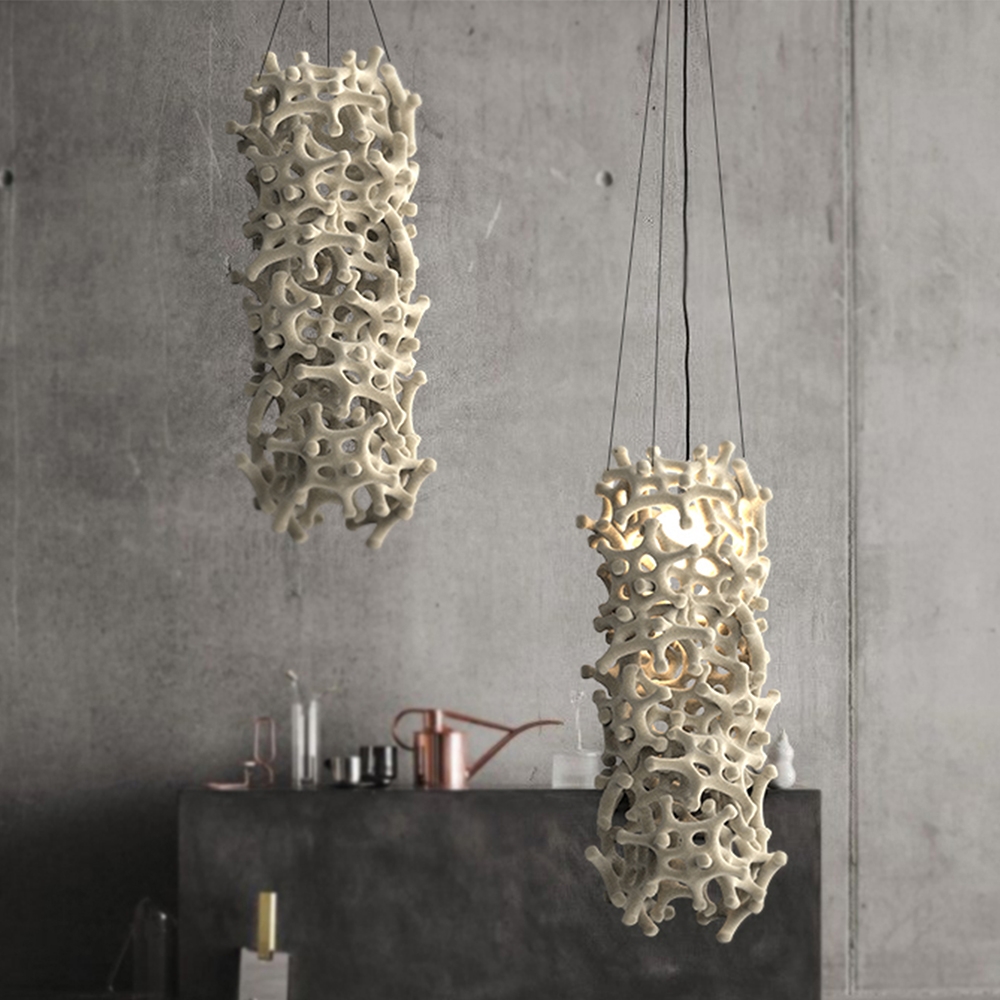
Ma-Ka Lighting System by Elsa Gil Benito
The Lighting System is made of a biomaterial, can you please explain how you create it and how long it takes? What are the benefits of it?
Mycelium can be described as the roots of mushrooms. It is considered one of the most powerful biomaterials with low cost, requirements, and ingredients. However, there are a lot of possibilities for contamination during the growing process. That’s why for the project I decided to buy Grow It Yourself kits: a useful resource to learn how to work with it and reduce the contamination range.
I fabricated my own thermoformed molds from my digital design. These molds are the ones that give shape to the mycelium, which adapts to its container. After an incubation period of four days, I took them off the molds and attached several pieces by hand, creating the final column. The mycelium keeps growing, so the structure can be bio-assembled by its expansion. For this big product, the whole process took me two weeks, including the drying step.
The potential of micomaterials becomes clear when we know their properties and understand that they can be compared to various traditional materials.
For example, chipboard, whose production starts with sawdust or wood chips agglutinated with special resins, so that it has the desired texture, density, and resistance.
It can be applied to architecture, interior design, products, etc. It is possible to manufacture chipboard, petroleum-derived plastics, and even fabrics for the textile industry from mycelium. Depending on how they are cultivated, they can have similar properties without the need to use resins or chemical gums. Mycelium is responsible for naturally binding the raw material. Depending on the object to be designed, we will have to consider different production models to achieve different properties.
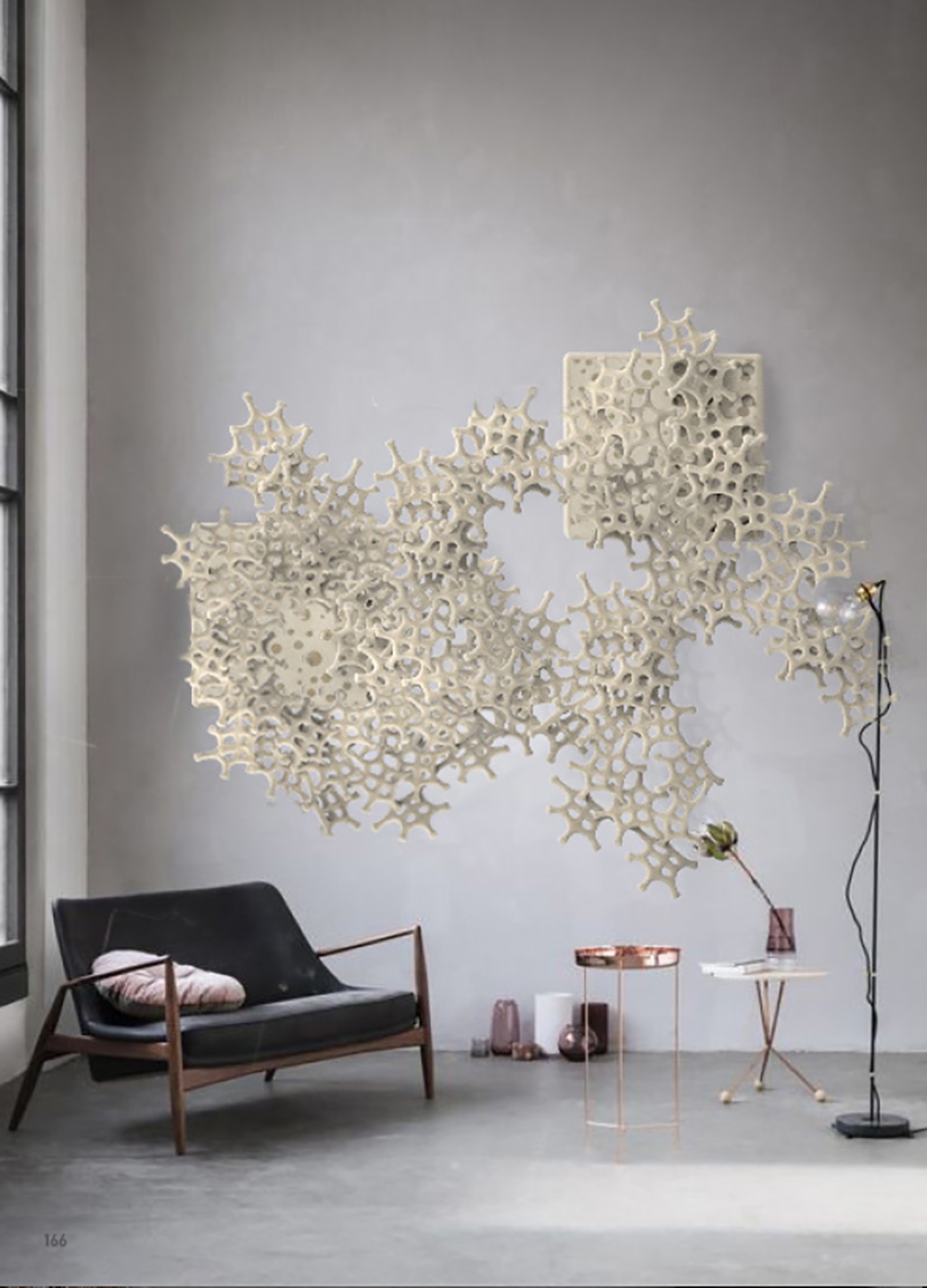
Ma-Ka Lighting System by Elsa Gil Benito
You are just starting your career as a Lighting Product Designer… what do you want to do next? What are your dreams?
Right now I am planning to start my journey in a PhD program, as I believe that it is through education and research that biodesign can enter our daily lives.
My dream is to have my own design studio where I could develop my projects and at the same time teach and research. My objective is to keep learning.
Last, what makes light magical to you?
For me, light becomes magical when there’s a game purpose: when you can decide to play with its shadows, and create your own magical environment.
We spoke with designer Mykola Kabluka about how his team at Ukrainian company Expolight is once again finding a way forward with light. Mykola, winner of the “Lighting Product Design of the Year” title, told us more about the creative journey in designing the chandelier at Unit City’s B14 campus in Kyiv, Ukraine.
Could you tell us a little about yourself?
Light is almost my whole life. A hobby in the form of light was born during my studies, although my specialty was not related to light. Immediately after graduating from university, I started Expolight, which this month turns 22. We are based in Dnipro, Ukraine.
How did you discover your passion for Lighting Product Design?
It all started with my fascination with light: how it radically transforms our perception of the world, our emotional state, our perception of ourselves in space, and our relationship with it. That’s why I became interested in lighting design. We have a sustained balance between both technical and artistic points of view. Because in the design of our elements, we treat light as an excellent tool, like an artist. To make a good painting you need brushes of different widths, thicknesses, and types. In a similar way, we gradually came to the point where we designed our lamps. And through our study of the nature of light and our thirst for the study of light, we were inspired by the effects of light in the atmosphere and in different conditions, such as varying sun positions, different states of air humidity, clouds, and shadows. An exciting material for researching light is glass, which is solid. But at the same time, it is one of the few materials that are translucent and can transform light in different ways: re-reflecting, scattering, and refracting it. And that’s what we dedicated the Optical Metaphor brand to. We equate the metaphor to natural phenomena, such as natural lighting, by designing unique light sources and using customized glass from our production as a light-transforming object.
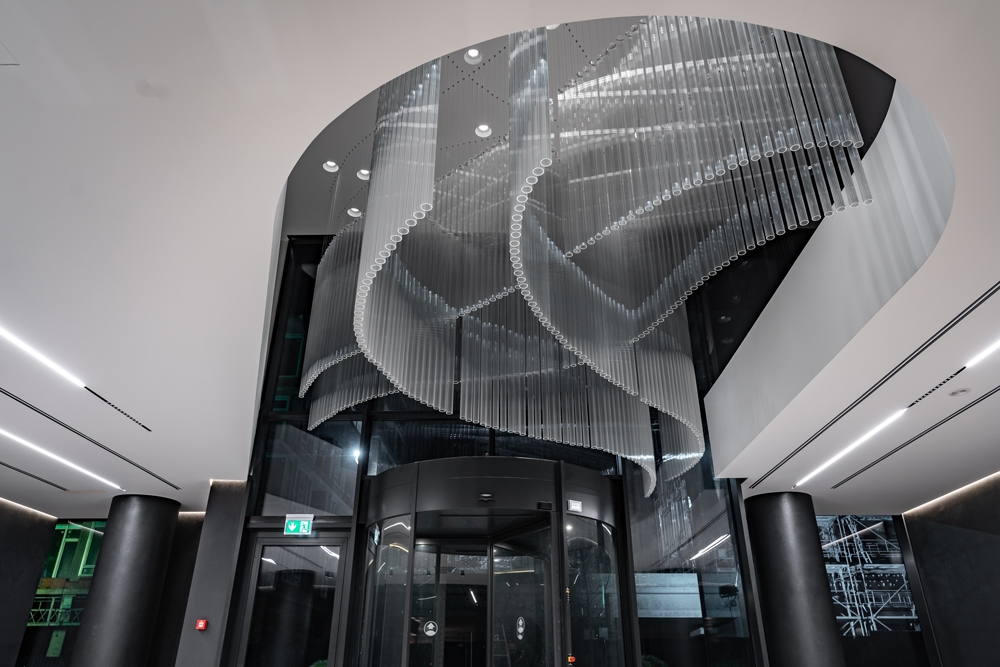
Photo Credit: Expolight
Can you please share with us, what was your creative journey when designing the chandelier? How would you describe the role and responsibilities when working on this design? What was the most challenging part of the project and how did you overcome it?
My approach to light is unusual. More often than not, a person is more inclined to either the technical part of the job, an engineering view of the world, or is more creative. And it happened that, to an equal degree, both spheres are close to me. My first education was in mathematical modeling, and my second was in lighting design. This combination expresses my approach to light. When we have an artistic image to create, we immediately see it and, from a technical angle, how it can be realized. This project is one of many planned for the huge Unit City Innovation Center complex. There we have illuminated many buildings, public spaces, and interior spaces. Hence, its philosophy is profoundly at the center of a modern view of the future of humanity, where technology is combined with the philosophy of care and sustainable interaction with nature. And this philosophy is reflected in all the elements we work on. We developed this project together with architect Victoria Yakusha and her Yakusha Design team. We wanted to make something that was both plastic and natural, but also technological. Because of this, we spent a long time selecting and designing these prismatic glass tubes and chose the illumination method to show the complexity of natural perception. So there are these complex, intersecting shapes that intertwine. They transform the light into an intricate image, which we did with our designed lenses, which have three types of beam widths at different angles so that these lenses and the multi-layered screens of these extremely long glass tubes covered with prisms create modern natural light, which at the same time is very technological.
One of the most challenging parts of the job was to design and achieve the production of such an incredibly long glass lens. We spent a long time adjusting our standard approaches to pouring a glass for such a long tube, 1600 mm long. That length is complicated to achieve, so we had to work on it, and it was also challenging, with such long rods, so closely spaced, to keep them from bumping against each other through the air from the vent.
We figured out how to lock the tubes in place, so they wouldn’t bump into each other, so we designed custom transparent and barely noticeable spacers made of optical plastic that replicated the grooved shape of the tube. They fix the chandelier so that it does not move and does not knock in its lower part. They are entirely invisible, so they do not destroy the overall clean and light appearance of the simple shape of the chandelier.
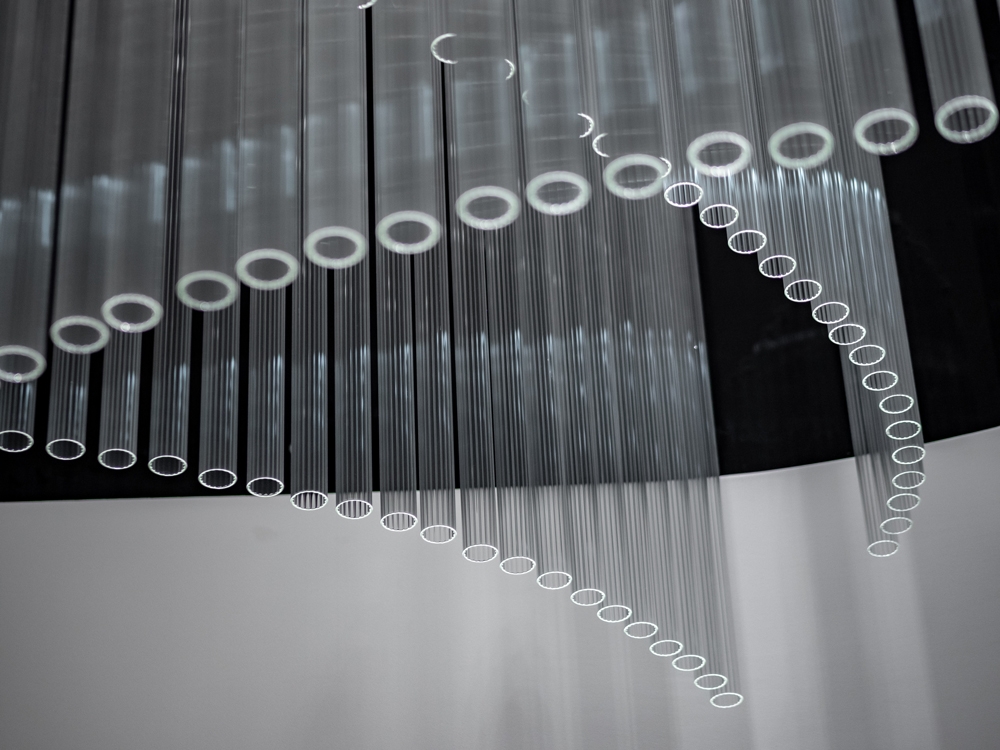
Photo Credit: Expolight
What does it mean to you, to win the Lighting Product Design of the Year 2022 prize?
This is very valuable and gratifying for our brand because it is a young brand that grew out of our passion for researching the natural phenomena of light and optical effects. But this award is precious because it is a motivating ray for Ukraine and Ukrainians. As you know, the situation in our country is now challenging because of Russia’s unjust aggression. Russia is plunging our entire country into darkness to destroy our energy system and leave us without electricity, heat, and water. Most of Ukraine now lives without stable electricity, heat, or communications. We never thought that one day we could do without what have always been such simple everyday things: charging gadgets, warm homes, and all that kind of stuff.
Therefore, we must be stable and work further, and this victory is very motivating for our company and the whole country because we live and move on. And it is symbolic to receive such bright news at the darkest moment. An interesting fact: We learned about this news literally at the darkest time: on November 15, immediately after the entire country was plunged into darkness during the first blackout due to the severe destruction of the Ukrainian energy system. My whole team and I were in the office and continued to work. Our office has all the conditions for this thanks to generators, Starlink, and an ample water supply (and soon, we will also have our well). This is how we continue to be in contact with the whole world and work in different corners of the world.
No matter how much Russia tries to plunge Ukraine into darkness, we want to show with our activities and victories that the light is still stronger and wins.
What are you working on at the moment, and do you have any upcoming projects or collaborations that you’re able to tell us about?
Now we have even more work to do around the world on different continents, and in the USA, Europe, and Great Britain. In the UAE, Armenia, Georgia, and Bali… There are many different countries; the geography is very wide. The situation in the country gave us an impetus to focus more on the international field. One of the most interesting projects now, where we also use our optical filter lenses, is one of the iconic properties in Dubai, with architecture by Zaha Hadid Architects. The task was to create unique lighting effects in the common space in the atrium of this impressive building. It is a great honor to work in facilities where such famous architects work. We created a custom floor lamp with our philosophy and are now in the final testing stage. It can be adjusted to create special caustic water effects; it has the appearance of the sun’s rays passing through the water and creating dynamic reflections. We love this effect.
What would be your best advice to Emerging Lighting Product Designers?
Be fascinated by the light. Light can be studied endlessly and is very interesting, as long as you look at it not as a practical entity that illuminates a dark space but rather as the inspirational-sacred function of light, which creates a mood, formulates our perception of the world, and inspires us. It is exciting to progress from the practical part to a higher level and study light as a metaphor for the natural phenomena in the modern world, combining it with modern technologies, while also studying basic light phenomena and reproducing them in your work.
Last, what can we wish you for 2023?
Please wish that democracy defeats totalitarianism and that Ukraine endures and wins in the fight against the totalitarian aggression of the Russian Federation. We are sure of this because light always wins over darkness.